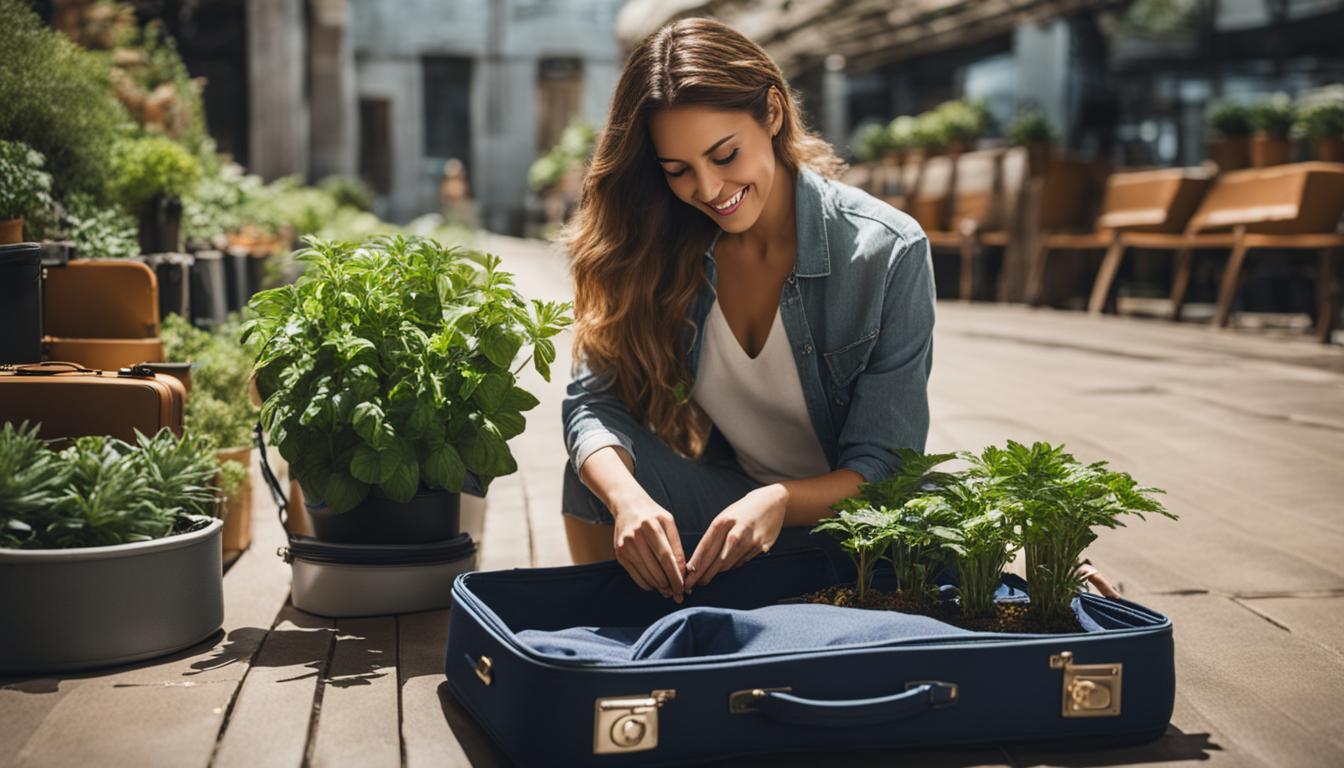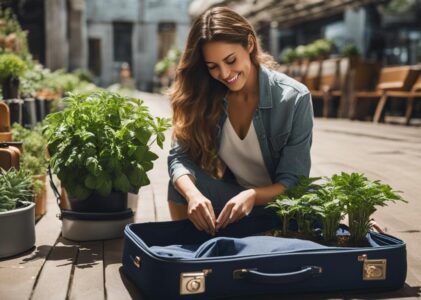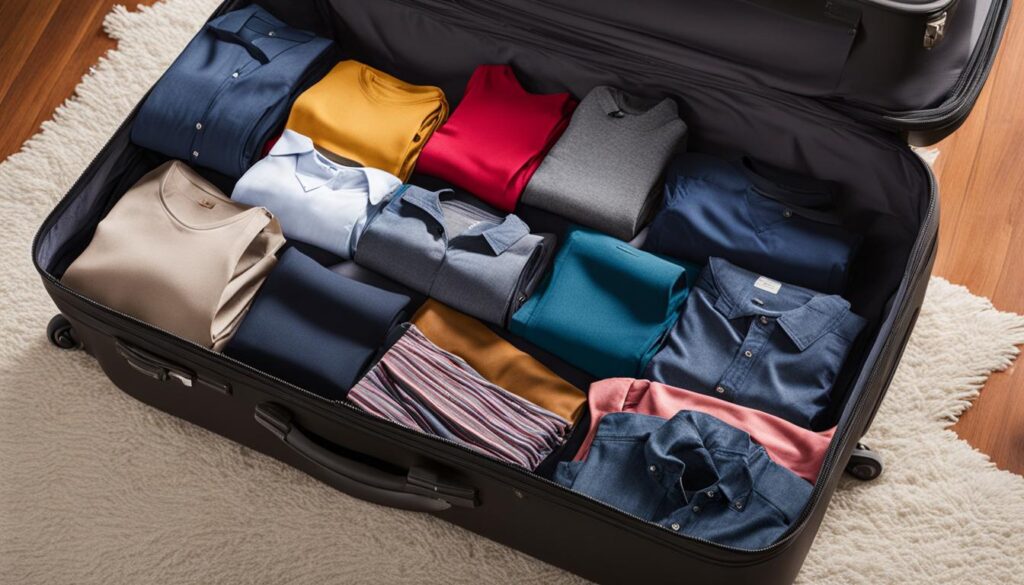Packing a plant in a suitcase may seem like a challenging task, but with the right techniques and materials, you can ensure that your leafy companion arrives at its destination unharmed. In this guide, I will provide you with step-by-step instructions on how to pack a plant in a suitcase, including helpful tips for protecting delicate plants, following TSA guidelines, and using essential packing materials.
Key Takeaways:
- Learn how to pack a plant in a suitcase safely and securely.
- Choose the right container for your plant to provide proper ventilation and protection.
- Prepare your plant by trimming, watering, and protecting it before packing.
- Secure the plant in the suitcase with cushioning materials to prevent shifting.
- Take climate conditions into consideration and comply with TSA guidelines.
Choose the Right Container for Your Plant
When packing a plant in a suitcase, selecting the appropriate container is crucial to ensure its safety during travel. Here are some suitcase plant packing tips to help you choose the right container:
- Opt for a lightweight, durable pot: Look for a pot that is not too heavy, as it will add unnecessary weight to your luggage. Additionally, choose a pot made of a durable material to avoid any breakage or damage during transit.
- Consider proper drainage: Make sure the container has adequate drainage holes at the bottom to prevent water from pooling and causing root rot. This will allow the plant’s roots to breathe and prevent overwatering.
- Use a plastic container for delicate plants: If you are traveling with delicate or fragile plants, it is advisable to use a plastic container. Plastic containers provide an extra layer of protection and minimize the risk of damage.
- Avoid oversized containers: Using a container that is too large for your plant can lead to shifting and potential damage during travel. Choose a container that is just the right size to provide stability and minimize movement.
By following these suitcase plant packing tips, you can ensure that your plant is packed in a suitable container, allowing it to withstand the journey and arrive at its destination unharmed.
Table: Container Options for Packing Plants in a Suitcase
| Container Type | Advantages | Disadvantages |
|---|---|---|
| Lightweight plastic pot | Provides extra protection for delicate plants | May not have aesthetic appeal |
| Terra cotta pot | Allows for better airflow and drainage | Can be heavier and more fragile |
| Resealable plastic bag | Great for small plants and prevents soil spillage | Offers minimal protection against physical damage |
| Mesh pot | Allows for additional airflow to the roots | Susceptible to breakage and leakage |
Packing Delicate Plants for Travel
Delicate plants require extra care when packing them in a suitcase. Here are some additional tips to ensure their safety:
- Wrap the pot in cushioning material: Use soft materials such as bubble wrap, tissue paper, or clean clothing to provide a protective layer around the pot. This will prevent it from shifting and minimize the risk of damage.
- Add padding around the plant: Place towels, clothes, or packing peanuts around the plant to provide extra cushioning. This will help absorb any shocks or impacts during transit and keep the plant secure.
- Label the suitcase as fragile: Clearly mark the suitcase containing delicate plants as “fragile” to ensure it receives special handling. This will alert airport staff to exercise caution when handling your luggage.
When packing delicate plants, it’s important to strike a balance between providing adequate protection and ensuring the plant has enough space to breathe. By following these packing tips, you can increase the chances of your delicate plants arriving safely at their destination.
Prepare Your Plant for Travel
Before packing your plant in a suitcase, it’s crucial to prepare it properly for travel. Start by trimming any dead or damaged leaves and branches. This will not only improve the appearance of the plant but also help it conserve energy during transit. Additionally, water the plant thoroughly a few days before your departure to ensure that it is well-hydrated but not overly saturated. This will prevent any potential soil spillage during the journey.
To further protect your plant, consider wrapping the pot with a plastic bag or cling wrap. This will prevent soil from spilling into your suitcase and keep the plant securely in place. It’s also a good idea to reinforce the packaging by placing the plant in a sturdy box or container within the suitcase. This will provide an extra layer of protection and minimize any potential damage from shifting during travel.
Essential Packing Materials for Plant Travel
When preparing your plant for travel, there are a few essential packing materials you should have on hand:
- Packing tape: Use this to secure the plastic wrapping and reinforce the packaging.
- Bubble wrap: Wrap delicate leaves and stems with bubble wrap to provide cushioning and prevent damage.
- Absorbent materials: Keep some newspaper or paper towels handy to absorb any excess moisture, preventing leakage.
- Sturdy box or container: Place the plant in a box or container that fits securely within your suitcase to provide extra protection.
By following these steps and using the right materials, you can ensure that your plant is well-prepared for its journey and arrives at its destination in excellent condition.
| Packing Tips | Benefits |
|---|---|
| Trim dead or damaged leaves | Improves plant’s appearance and conserves energy |
| Thoroughly water the plant | Prevents soil spillage during travel |
| Wrap the pot with plastic | Secures the plant and prevents soil from spilling in the suitcase |
| Use packing tape and bubble wrap | Provides extra protection and cushioning during transit |
| Keep absorbent materials handy | Prevents leakage from excess moisture |
| Place the plant in a sturdy box or container | Provides an additional layer of protection |
Secure the Plant in the Suitcase
Now that you have prepared your plant for travel, it’s time to secure it in the suitcase. This step is crucial to ensure that your plant stays in place and is protected during transit. Follow these steps for the best way to pack a plant in a suitcase:
- Place the pot in a plastic bag: To prevent soil spillage, place the pot in a plastic bag. This will also protect the pot from any potential damage.
- Position the plant in the center: Put the plant in the center of the suitcase. Make sure it is stable and won’t shift during travel.
- Add cushioning: Use clothes or towels to create a cushioning layer around the pot. This will help prevent any movement and provide extra protection.
- Consider additional padding: If you are traveling with delicate or fragile plants, consider adding additional padding, such as bubble wrap or foam, to provide extra protection.
By following these steps, you can ensure that your plant is securely packed in the suitcase, ready for a safe journey to its destination.
“Properly securing your plant in the suitcase is essential to prevent any damage during transit.”
Table: TSA Guidelines for Packing Plants
| TSA Guidelines | Requirements |
|---|---|
| Allowed in carry-on baggage | Check TSA website for specific regulations and plant species |
| Allowed in checked baggage | Check TSA website for specific regulations and plant species |
| Additional documentation or permits | Check TSA website for specific regulations and plant species |
| Size and weight restrictions | Check TSA website for specific regulations and plant species |
Before packing your plant, it’s important to check the TSA guidelines to ensure that you comply with the regulations. The table above provides a summary of the general TSA guidelines for packing plants. However, it’s always best to check the TSA website for the most up-to-date and specific regulations based on the plant species you are traveling with. By following the TSA guidelines, you can avoid any issues or delays during airport security checks.
Pack Soil and Water Carefully
When preparing to pack a plant in a suitcase, it’s essential to take care when dealing with soil and water. Soil can be messy and cause leaks during travel, and excess moisture can lead to leakage and potential damage to your plant. To prevent these issues, follow these tips for packing soil and water carefully:
Table: Packing Soil and Water Carefully
| Packing Tip | Description |
|---|---|
| Cover the soil | Carefully cover the top of the soil with plastic wrap or a plastic bag. Secure it tightly around the base of the plant to prevent soil spillage during transit. |
| Avoid over-watering | Before packing, make sure not to over-water the plant. Excess moisture can lead to leakage and potential damage. Only water the plant as necessary a few days before your departure. |
| Use absorbent materials | If there is excess moisture, consider using absorbent materials like newspaper or paper towels to soak it up. These materials can help prevent leaks during transit. |
By following these tips, you can ensure that your plant’s soil and water are packed securely and won’t cause any issues during travel. Remember to check the soil and water conditions upon arrival to ensure that your plant is in optimal health.
Pack Delicate Plants with Care: Protecting Your Leafy Friends in a Suitcase
When it comes to traveling with delicate plants, providing adequate air circulation is crucial for their well-being. To ensure your leafy friends stay healthy during transit, it’s important to pack them in a way that allows for proper airflow. By providing sufficient space and preventing tight packing, you can minimize the risk of damage and help your plants thrive.
If you’re traveling with multiple plants, consider using separate suitcases or dividers to provide each plant with adequate air circulation. This will help prevent overcrowding and allow for optimal airflow around each plant. Additionally, avoid packing the suitcase too tightly with clothes or other items, as this can restrict airflow and increase the chances of damage.
Creating Space for Airflow
When packing your delicate plants, ensure that there is some open space around the plant in the suitcase. This space will allow for proper ventilation and prevent the plant from overheating or suffocating during travel. By leaving a bit of breathing room, you can help your plants stay fresh and healthy throughout the journey.
Tip: Consider placing breathable materials, such as paper or fabric, between your plants to allow for airflow while protecting them from shifting or rubbing against each other.
In addition to providing adequate air circulation, be mindful of the environmental conditions your plants will be exposed to during travel. Avoid placing the suitcase containing your plants in direct sunlight or near sources of extreme heat or cold. Maintaining a stable temperature and protecting your plants from harsh environmental conditions will contribute to a successful journey and keep your leafy friends thriving.
| Tip | Protect Your Plants |
|---|---|
| 1 | Avoid packing plants too tightly |
| 2 | Consider using separate suitcases or dividers for multiple plants |
| 3 | Leave some open space around the plant for airflow |
| 4 | Avoid exposing plants to direct sunlight or extreme temperatures |
By following these packing tips and ensuring your delicate plants have adequate air circulation, you can protect them from damage and help them thrive throughout your travels!
Label and Protect Fragile Plants
If you are traveling with delicate or fragile plants, it’s important to take extra precautions to ensure their safety during transit. Here are some tips on the best way to pack a plant in a suitcase and protect it from damage:
1. Clearly label the suitcase
Give special attention to labeling the suitcase containing fragile plants. Use a bright-colored luggage tag and write “Fragile – Handle with Care” in clear, bold letters. This will alert baggage handlers to take extra precautions and minimize the risk of mishandling during transportation.
2. Use shock-absorbing materials
To protect delicate leaves and stems, wrap your fragile plant in foam or bubble wrap. These materials provide cushioning and absorb shock, minimizing the risk of damage during handling and transit. Secure the wrapping with packing tape to ensure it stays in place.
3. Pack the plant tightly
To prevent shifting and movement during travel, make sure the plant is packed tightly in the suitcase. Use clothes or towels to fill any empty spaces around the plant and provide additional cushioning. This will help keep the plant secure and minimize the risk of damage caused by shifting during transit.
By following these guidelines, you can give your fragile plants the best possible protection and increase the chances of them arriving at their destination in perfect condition.
Consider Climate Conditions
When packing plants for travel, it’s essential to consider the climate conditions to ensure the well-being of your leafy companions. Different plants have specific temperature and humidity requirements, so it’s important to take necessary precautions. If you’re traveling to a destination with extreme temperatures, such as hot or cold climates, you’ll need to protect your plants from potentially damaging conditions.
To safeguard your plants from extreme temperatures, consider using insulated packing materials to regulate the temperature inside the suitcase. You can also use heat packs to provide warmth in cold weather. It’s crucial to avoid exposing your plants to direct sunlight or extreme cold for extended periods during transit. This can help prevent wilting, freezing, or heat stress, which can be detrimental to the health of your plants.
Additionally, maintaining proper airflow is important for your plants’ well-being. Ensure that there is adequate ventilation in the suitcase to prevent excessive heat buildup or lack of oxygen. Avoid packing the suitcase too tightly, as this can restrict airflow and increase the risk of plant damage. If you’re traveling with multiple plants, it may be beneficial to use separate suitcases or dividers to provide each plant with sufficient air circulation.
By considering the climate conditions and providing suitable protection for your plants, you can help ensure that they arrive at their destination in good health. Remember to check the specific temperature and humidity requirements for your plants before you travel, and take the necessary steps to provide the ideal conditions for their journey.
TSA Guidelines for Packing Plants
When traveling with plants, it is crucial to adhere to TSA guidelines to ensure a smooth journey. Here are some key regulations to keep in mind:
1. Carry-on vs. Checked Baggage:
Before packing your plant, determine whether it can be transported in carry-on or checked baggage. Each specific plant species may have different restrictions, so be sure to check with TSA beforehand.
2. Documentation and Permits:
Some plants may require additional documentation or permits for transport, especially if they are rare or endangered. Research and obtain the necessary paperwork well in advance to avoid any complications at the airport.
3. Size and Weight Restrictions:
Ensure that the suitcase containing the plant complies with TSA’s size and weight restrictions. Oversized or excessively heavy baggage may incur additional fees or be denied for transport.
4. Accessibility for Inspection:
Be prepared for possible inspection by TSA agents. Pack the plant in a way that allows easy access and reassembly if required. Avoid using excessive sealing or wrapping that may obstruct the view of the plant during security checks.
| TSA Guidelines for Packing Plants | |
|---|---|
| Carry-on vs. Checked Baggage | Pack plants in accordance with the specified guidelines for carry-on or checked baggage. |
| Documentation and Permits | Obtain the necessary documentation or permits for transporting rare or endangered plant species. |
| Size and Weight Restrictions | Ensure that the suitcase with the plant adheres to TSA’s size and weight restrictions. |
| Accessibility for Inspection | Make the plant easily accessible for inspection without compromising its security. |
By following the TSA guidelines, you can avoid any potential issues or delays during your travels with a plant. Always stay informed and plan ahead to ensure a hassle-free journey.
Unpack and Reacclimate Your Plant
Once you arrive at your destination, it’s time to unpack your plant and get it settled into its new environment. Here are the steps to follow:
- Remove any packing materials: Gently take out the plant from the suitcase and carefully remove any bubble wrap, foam, or other packing materials. Be cautious not to disturb the plant too much while doing this.
- Inspect for damage: Examine the plant closely for any signs of damage during transit. Look for broken stems, wilted leaves, or soil spillage. If you notice any issues, take immediate action to address them.
- Trim and adjust: If the plant has shifted or suffered damage, you may need to trim off any damaged leaves or branches. Also, assess the lighting and temperature in the new location and make any necessary adjustments to ensure the plant receives the right conditions.
- Gradual reintroduction: Give your plant time to acclimate to its new surroundings. Start by placing it in a well-lit area with indirect sunlight. Gradually increase the exposure to sunlight over a few days while monitoring the plant’s response. Continue to provide regular care, watering as needed, and maintaining appropriate humidity levels.
By unpacking your plant carefully and helping it reacclimate, you’ll give it the best chance to thrive in its new environment.
| Step | Description |
|---|---|
| 1 | Remove any packing materials |
| 2 | Inspect for damage |
| 3 | Trim and adjust |
| 4 | Gradual reintroduction |
Maintain Proper Plant Care During Travel
When packing a plant in a suitcase for travel, it’s crucial to provide proper care to ensure its well-being throughout the journey. Here are some essential plant packing essentials and tips for protecting plants in a suitcase:
1. Temperature and Lighting
During transit, it’s important to avoid exposing the plant to extreme temperatures or direct sunlight for extended periods. These conditions can harm the plant’s health and vitality. If you’re traveling in hot weather, consider using insulated packing materials or heat packs to maintain a stable temperature. Conversely, if you’re traveling in colder temperatures, take precautions to protect the plant from freezing.
2. Watering and Humidity
Maintaining proper hydration is crucial for the well-being of your plant while in transit. Before packing your plant, ensure that it’s adequately watered but not overly saturated. Excess moisture can lead to leakage and potentially damage the plant. If your journey is long, consider investing in a self-watering device or asking a trusted friend or neighbor to check on your plant and provide necessary care while you’re away.
3. Air Circulation
Proper air circulation is essential for the plant’s health and vitality during travel. Leave some open space around the plant in the suitcase to ensure adequate airflow. Avoid packing the suitcase too tightly, as this can restrict airflow and increase the risk of damage to the plant.
4. Monitoring and Inspection
While in transit, periodically check on your plant to ensure it’s doing well. If possible, open the suitcase in a well-ventilated area and assess the condition of the plant. Look for any signs of damage or stress and take immediate steps to provide appropriate care if needed. Additionally, following TSA guidelines and labeling your suitcase with fragile plants can help ensure that it’s handled with care during transportation.
By following these plant packing essentials and providing proper care during travel, you can increase the chances of your plant arriving at its destination in good health. Remember to unpack and reacclimate your plant as soon as you reach your destination to help it adjust to its new environment.
| Plant Care Tips |
|---|
| Ensure proper temperature and lighting conditions during travel |
| Adequately water the plant before packing and consider a self-watering device for long journeys |
| Allow for proper air circulation in the suitcase |
| Regularly monitor and inspect the plant while in transit |
Conclusion
In conclusion, packing a plant in a suitcase can be a bit challenging, but by following the right techniques and using proper materials, you can ensure the safe travel of your leafy companion. Starting with choosing the right container, such as a lightweight and durable pot with proper drainage holes, is crucial for the plant’s well-being during transit. It’s also important to prepare your plant by trimming dead leaves and branches and watering it properly a few days before your trip.
To secure the plant in the suitcase, place it in a plastic bag to prevent soil spillage and position it securely in the center. Use clothes or towels for cushioning and consider adding extra padding, like bubble wrap, for fragile plants. Packing the soil and water carefully is essential to avoid leaks and spills. Cover the soil with plastic wrap or a bag and avoid overwatering to prevent excess moisture.
Providing adequate air circulation is key to keeping your plant healthy during travel. Leave some open space around the plant in the suitcase and avoid packing it too tightly. If you have fragile plants, label them as fragile and use shock-absorbing materials for added protection. Finally, don’t forget to check TSA guidelines, consider climate conditions, and unpack and reacclimate your plant upon arrival. By following these steps, you can confidently pack and travel with a plant in a suitcase.
FAQ
What type of container should I use to pack my plant in a suitcase?
Opt for a lightweight, durable pot with proper drainage holes. Consider using a plastic container for delicate plants for added protection.
How should I prepare my plant before packing it in a suitcase?
Trim any dead or damaged leaves and branches. Water the plant thoroughly a few days before your departure. Wrap the pot with a plastic bag to prevent soil spillage.
How do I secure the plant in the suitcase?
Place the pot in a plastic bag and secure it in the center of the suitcase. Use clothes or towels for cushioning and consider adding extra padding for fragile plants.
How can I prevent soil spillage and water damage during travel?
Cover the top of the soil with plastic wrap or a plastic bag and secure it tightly. Avoid over-watering the plant before packing and use absorbent materials for any excess moisture.
How do I ensure adequate air circulation for the plant during travel?
Leave some open space around the plant in the suitcase and do not pack it too tightly. Consider using separate suitcases or dividers for multiple plants.
How can I protect fragile plants during travel?
Label the suitcase as fragile and use shock-absorbing materials like foam or bubble wrap. Secure the plant and protective materials with packing tape.
What should I consider regarding climate conditions during travel?
Take necessary precautions if traveling to destinations with extreme temperatures. Use insulated packing materials or heat packs to maintain a stable temperature.
What TSA guidelines should I follow when packing plants in a suitcase?
Check if the specific plant species is allowed in carry-on or checked baggage. Follow size and weight restrictions and be prepared for possible inspection by TSA agents.
How should I unpack and care for the plant once I reach my destination?
Remove packing materials and inspect the plant for damage. Provide proper care if necessary, adjusting light and temperature gradually.
How do I maintain proper plant care during travel?
Avoid exposing the plant to extreme temperatures or direct sunlight. Consider using self-watering devices or asking someone to check on the plant while you’re away.




